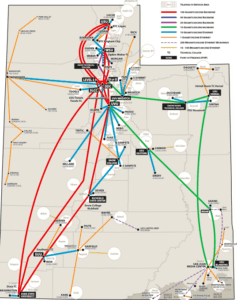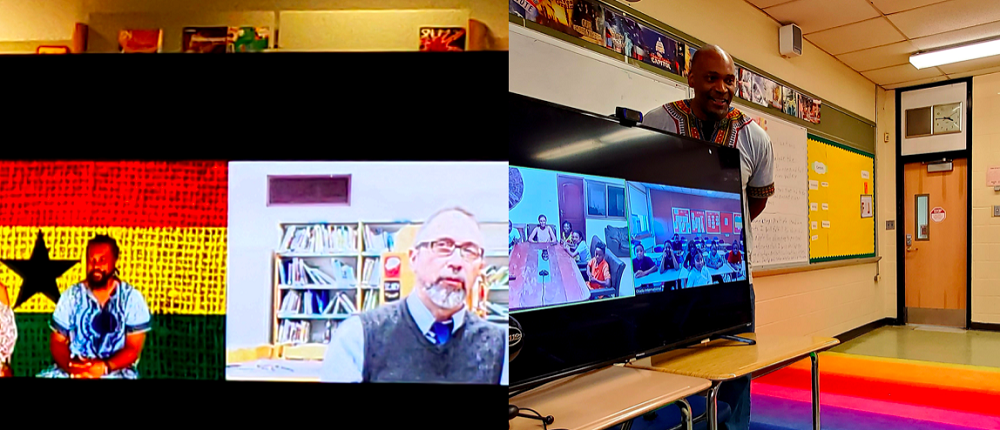Editor’s note: Commercial Integrator has teamed up with the IMCCA, the New York-based non-profit industry association for unified communication and workplace collaboration, to produce a quarterly supplement, titled Collaboration Today and Tomorrow, that focuses on all things collaboration from multiple perspectives.
As I reflect upon my 30-plus years in distance education and training, I see the emboldened promise of collaborative technologies even more now due to the COVID-19 pandemic. The global death and suffering due to the pandemic have clearly been a horrific thing. However, through it all, I think the world has also taken notice of the role technology has played in improving collaboration. My experience — it ranges from interactive satellite broadcast/videoconferencing to modeling and simulation/serious games — allows me to reflect from a unique perspective.
Collaboration technologies in education existed for many years before the pandemic, and the whole space encompasses much more than you may might think.
An Enduring Legacy
In the 1990s, I remember working for the Black College Satellite Network (BCSN), which was founded in 1981 by Dr. Mabel P. Phifer and Dr. Walter C. Barwick. Although BCSN is no longer in existence today, its legacy lives on across Historically Black Colleges and Universities (HBCUs) — and beyond. This is because BCSN was at the forefront of developing and deploying telecommunication infrastructures that aimed to fuel the development and support of HBCU distance-education programs. This was my first taste of collaboration via the use of interactive videoconferencing and satellite technologies. The impact I saw on colleges, organizations and school systems was impressive.
Most of the people new to distance learning over the last couple of years probably think it refers only to videoconferencing (Zoom, Webex, Teams, etc.) or some other specific type of technology. In fact, the term “distance learning” encompasses the full array of current and emerging technologies that organizations are using to deliver educational experiences and products.
According to Holden, Westfall and Gamor (2010), “Distance learning includes e-learning, texting, social networking, virtual worlds, game-based learning, webinars and a lot more. It’s the internet. It’s Google. It’s broadband and satellite and cable and wireless. It includes corporate universities; virtual universities; blended learning; mobile learning. It’s using our phones and computers and whatever technology comes next, all in new and different ways not yet realized. Distance learning brings education and training to where students or trainees are, connecting their world to worldwide learning communities.”
Related: Do Schools Need Integrators for Distance Learning Projects?
As a matter of fact, not too long ago (and before the other tools), there was an initiative launched by the National Guard Bureau (NGB) called the Distributive Training Technology Project (DTTP). DTTP provided community-based distributive learning classrooms that increased access to military training at the lowest possible cost. The project complemented the Total Army Distance Learning Program (TADLP) by providing additional classrooms and access.
DTTP converted available space in armories, colleges, libraries and other locations into high tech classrooms. Classrooms were linked via state-of-the-art telecommunications to centralized training and teleconference facilities in all 50 states, three territories and the District of Columbia, resulting in a fully interactive training infrastructure where both military and civilian studies could be conducted. More than 300 classrooms were installed in a wide variety of configurations.
DTTP’s multimedia classrooms were connected by GuardNet, the Guard’s network that carried voice, video and data for NGB initiatives.
Averting Potential Devastation
With the pandemic still running its course, we only need to look back to March 2006 to see how the National Guard leveraged DTTP with the chief of the National Guard Bureau (CNGB) to successfully conduct a nationwide Pandemic Influenza (PI) Tabletop Exercise (TTX) via video-teleconference (VTC) and audio-conference with participants in the 50 states, two territories, the Commonwealth of Puerto Rico, and the District of Columbia. The TTX was designed to enhance the ability of the National Guard and State Emergency Management Agencies to plan for and respond to a PI outbreak and its potentially devastating effects.
The TTX itself was conducted as an unclassified, multipoint videoconference. This event was considered a resounding success and connected more sites than any other single National Guard event. It included 95 sites, 1,237 participants and 38 Multipoint Control Units (MCUs), including three Interim Satellite Incident Site Communications Set (ISISCS) kits, one Joint Incident Site Communications Capability (JISCC) kit and the J3 conference at the Riviera Hotel in Las Vegas. Again, leveraging collaborative technologies connecting classrooms, video bridges and even satellite proved to set the stage for later use in this present day.

The Utah Education and Telehealth Network (UETN) supports equity, reduces barriers and provides high-capacity circuits to schools, colleges, universities and libraries, plus hospitals, clinics and rural health departments across the state.
Another example of the use of collaborative technologies can be seen via the Utah Education and Telehealth Network (UETN). James Hodges, Video Operations Center (VOC), UETN notes that, “the Utah Education and Telehealth Network is Utah’s broadband provider for education and telehealth. UETN supports equity, reduces barriers and provides high-capacity circuits to schools, colleges, universities and libraries, plus hospitals, clinics and rural health departments. UETN serves more than 675,000 public school students, more than 202,000 college students, and more than 78,000 faculty and staff in public and higher education. It also connects more than 70 hospitals, clinics and health departments. In addition, it operates a public television station KUEN, also known as UEN-TV, on behalf of the Utah System of Higher Education.”
The collaborative scale with which UETN operates is impressive, and even more so when one considers that they connect schools, colleges and healthcare providers for the greater good.
In that same vein, “the Center for Interactive Learning and Collaboration (CILC) is a non-profit organization that provides equal access to educational and cultural opportunities for all communities by supporting K-12 educators with authentic, relevant and interactive learning experiences. Through virtual interactive program offerings, students and educators have access to limitless learning opportunities, from math, science and tech to art, language and history from hundreds of cultural organizations, heritage centers, and diverse content experts,” says Jan Zanetis, managing director, CILC.
Expanding Effective Learning Opportunities
The use of collaborative technologies is about using available technologies and technology infrastructures to make more effective learning opportunities accessible to all learners. This should be without regard to their age, location or reason for learning. These opportunities should also be available anywhere, at any time, at any pace, meeting the individual needs of each student. It most closely resembles the way work will occur and economies will expand in this century, remotely and in collaboration with multiple and diverse stakeholders.
Eric Jones, CEO, Oiada International, remarks, “Oiada International is another such non-profit organization and content provider for CILC that has been providing award-winning educational and experiential programs via videoconference, [taking] learning beyond the four walls of the school building. Since the opening of their New Jersey and Ghana, West Africa centers in 2009, over 450,000 students in 50 U.S. states and 32 countries worldwide have engaged in their programs. [For example], Oiada’s Visa Program is an academic videoconference exchange program that pairs classrooms in different countries using a shared project-based learning curriculum to build students’ skills in communication, collaboration, and critical thinking. Curricular activities blend in-class learning and video conference engagement. The key program feature of our Visa Program is the face-to-face interaction and the social network built and curated for each classroom pair to share project based curricular activities and cross-cultural interactions.”
Keep in mind that the examples of collaboration noted here are exceptional programs. Since the pandemic, more people have had to use collaborative technologies across a wide spectrum of actives for work, telehealth and even new creative programs.
Related: AGT & Spatial Help Outfit Immersive Soundscapes for Healthcare Workers
According to Grand View Research, Inc. (June 2021), “The global videoconferencing market size was valued at $4.21 billion in 2020 and is expected to expand [with a revenue forecast in 2028 of $9.95 billion]. Furthermore, lockdowns implemented amid the COVID-19 pandemic globally have resulted in a massive rise in demand for videoconferencing and teleconferencing solutions as businesses and individuals sought ways of remaining connected.”
Fostering Engagement, Presenting Opportunities

Black Girls Dive Foundation, Inc. is a nonprofit science education organization which exposes girls and young women to Science, Technology, Robotics, Engineering, the Arts, Mathematics and Scuba (STREAMS) though aquatic-based recreation, research and career opportunities.
This projected growth in videoconferencing/collaborative technologies will continue to foster engagement and even present more collaborative opportunities for an even more diverse global community. Black Girls Dive Foundation, Inc. (BGDF), is one outgrowth of these programs. The foundation is a nonprofit science education organization which exposes girls and young women to Science, Technology, Robotics, Engineering, the Arts, Mathematics and Scuba (STREAMS) though aquatic-based recreation, research and career opportunities.
Dr. Nevada Winrow, founder, notes, “BGDF has a Shark Research and Conservation initiative, which is a collaborative partnership with the Rosenstiel School of Marine and Atmospheric Science – University of Miami that introduces participants to the world of Sharks. Through demonstrations and in-class exercises utilizing interactive videoconferencing, students work with real shark biotelemetry data and are taught basic spatial analysis of shark satellite data.”
So, along with all its horrors, COVID-19 didn’t invent distance learning. What it did do was shine a light on the need for quality programs and resources (not just webcams stuck in front of classroom teachers). There have been and there will continue to be organizations and projects that will contribute to an ever-increasing collaborative community for the benefit of humankind.
Educators will find new and better ways to leverage collaborative technologies that lift the human spirit with a glimmer of hope through all our future crises. Our technological community needs to be at the forefront of helping launch these kinds of outstanding distance-learning programs.
The next time someone tells you that remote and hybrid learning during the pandemic was “bad,” you can and should agree with them — but not because it can’t be done well. Sadly, only because, typically, it wasn’t done well.
For more Collaboration Today and Tomorrow content, check out our website archives.
Dr. Reggie Smith III is chief operations and innovation officer with Black Girls Dive Foundation, Inc.










